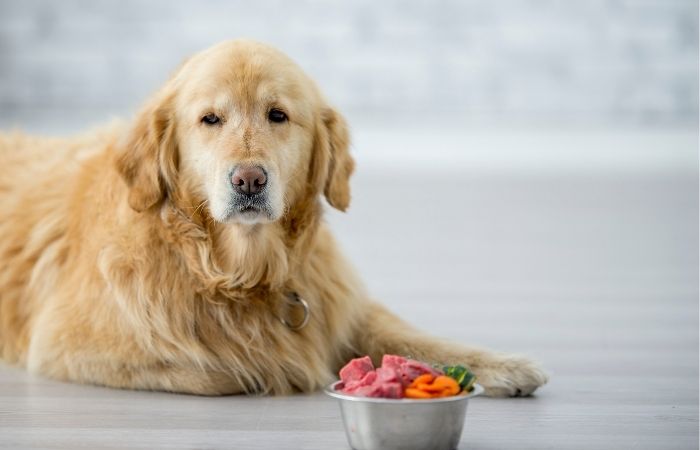Hypoallergenic dog food is a term used to describe dog food which doesn’t contain ingredients that are known to cause allergic reactions in dogs.

Hypoallergenic dog food can be found in many different forms, from canned food to dry food to even treats. Most people who buy hypoallergenic dog food think they are buying the best food for their dogs, but this isn’t always the case.
Related: Best Hypoallergenic Dog Food
In this article, we will explore what exactly hypoallergenic dog food is, and the different kinds of foods available. We will look at some reasons why hypoallergenic dog food might not be the best for your dog, and we will explore the benefits of using a natural alternative to hypoallergenic dog food.
What Is Hypoallergenic Dog Food?
Hypoallergenic dog food is food that has been formulated without any of the top eight common allergen triggers, which are listed below:

Dogs are generally sensitive to these eight common allergens:
- Wheat
- Milk
- Soy
- Egg
- Nuts
- Peanuts
- Fish
- Shellfish
As you can see, hypoallergenic dog food is a relatively new idea, and there are still very few foods that actually fit the definition of hypoallergenic dog food. For that reason, most hypoallergenic dog foods have come from the natural pet food market, and they are often made from food that is naturally hypoallergenic.
Why Should You Feed Your Dog a Hypoallergenic Diet?
Most people who choose to feed their dogs a hypoallergenic dog food diet will do so for one of two main reasons:
- The dog has been diagnosed with a food allergy
A dog with a food allergy needs to avoid certain foods, which means that he will be eating a hypoallergenic dog food diet instead. Most hypoallergenic dog foods have a list of allergens that they don’t contain, so it will be easy to determine which foods your dog should avoid. If your dog has a food allergy, you should consult with your vet to determine the best hypoallergenic dog food diet for your dog.
- The dog is a picky eater
Some dogs can eat a variety of foods, while others only want a very limited diet. When your dog does not eat a variety of different foods, it is usually because he is not interested in the food. He may also prefer to eat foods that are easier to digest.
What should I do if my dog has allergies?
If your dog is having problems with his skin or itchy eyes, nose and/or mouth, there are a few things you can try to help him. The first thing to do is to remove any pollen that might be causing the problem. If your dog is in the city, you can take him outside and let him run around. If your dog is out in the country, you might want to consider getting a spray for pollen control.

Some people use a spray on their lawns to keep the pollen from entering their home. If your dog has been running in the woods or fields, he may have picked up some pollen on his feet, and this could cause him to have a reaction. If you find that pollen is not the problem, there are other things you can try to help your dog. First of all, make sure that your dog has plenty of clean water. Make sure that your dog has access to a clean place to urinate and defecate. If you think that your dog has an upset stomach, you can give him a small amount of milk, but do not give him anything that is too sweet. You can also give your dog some anti-itch medications such as Vetrolin (Vectra) – Vectra is a product that can be used to control itching and skin irritation in dogs.
Things to keep in mind regarding Hypoallergenic Dog Food
If you are feeding your dog a hypoallergenic diet, you may be wondering what it is, and if it is safe for your dog. In fact, you may be thinking of switching to a hypoallergenic dog food because you think it is safer for your dog.
However, there are a few things that you should know about the new trend of hypoallergenic dog food before you decide to switch. The term “hypoallergenic” refers to foods that are designed to reduce the likelihood of your dog developing allergies or other adverse reactions when exposed to certain ingredients. The most common ingredient in hypoallergenic diets is fish protein.
There are two types of hypoallergenic diets: dry and wet.
Both are suitable for dogs with food allergies, but hypoallergenic diets are often less costly than other pet foods and may help prevent gastrointestinal problems caused by eating other pet foods. Dry Hypoallergenic Dog Food Hypoallergenic dog food is dry because it is not mixed with any water. Dry hypoallergenic dog food is perfect for dogs with sensitive stomachs. Dry hypoallergenic dog food has a lower calorie content than other dry dog foods because it contains fewer carbohydrates. Many dry hypoallergenic dog foods contain no artificial flavors, colors or preservatives. This means that they are free of harmful chemicals and additives. Most dry hypoallergenic dog foods also contain a high percentage of protein. Wet Hypoallergenic Dog Food Wet hypoallergenic dog food is mixed with water. This type of hypoallergenic dog food is more nutritious than dry food because it includes more protein.
What are the benefits of hypoallergenic dog food?
The benefits of hypoallergenic dog food include the following:
Hypoallergenic dog food is designed to be less likely to cause allergic reactions in your dog. The most common allergic reactions are skin allergies and digestive problems. Allergic reactions can cause your dog’s skin to become itchy or inflamed, and digestive issues may result in diarrhea or vomiting. These symptoms may look like other health issues such as a skin infection or stomach upset.
In addition to avoiding allergic reactions, hypoallergenic dog food will help prevent gastrointestinal issues and help improve your dog’s overall health. Hypoallergenic Dog Food vs. Raw Meat Diet Raw meat diets have been popular for years among dogs who are highly active or work outside. But the benefits of raw meat diets are only part of the story. Some owners choose to feed their dogs raw meat because they don’t want to give them any processed food. Others prefer the idea of feeding their dogs only the freshest, most natural ingredients. While many people see raw meat diets as the best way to feed a dog, it is important to remember that raw meat diets do carry some risks. For example, raw meat diets can be dangerous if your dog has a compromised immune system, is prone to certain cancers, or has other health conditions that make him more vulnerable to illness. Because of these potential dangers, it’s important to consider other options when looking for a healthy dog diet.
The difference between allergies and intolerances?
There is a difference between allergies and intolerances, but you don’t know it unless you have a clear understanding of what each one is. I’ll try to explain the difference to you. Allergies are caused by an overreaction of the immune system, triggered by something foreign to our body. Allergies are generally not life-threatening, but they can be quite uncomfortable and can even make us sick.
Intolerances are caused by the way we digest certain foods. Intolerances do not usually cause inflammation or other health problems, but they can be quite uncomfortable and are often difficult to tolerate. Most of us will have both kinds of food intolerance at some point in our lives. But most people don’t realize that they have these intolerances because the symptoms are so similar to those of allergies. Most people have had food intolerances since they were little kids. And when you have a food intolerance, you will have reactions to every food you eat. This includes dairy products. It’s a common misconception that milk is good for children because it contains calcium. The fact is, milk also contains casein, which causes many people to have digestive problems. Milk has always been associated with illness in children. In fact, milk was once banned in hospitals because of the high incidence of diarrhea in infants who were fed it.
Is hypoallergenic dog food the same as grain free?
Hypoallergenic dog food does not mean the same as grain free. Grain free refers to the removal of the grain ingredients like corn, wheat, oats, etc. From an allergy standpoint, grain free dogs are healthier because they eliminate the need for dogs to consume these allergens, but they are not the same. Hypoallergenic dog food can include these ingredients, but it may contain other ingredients that do not trigger allergic reactions. Hypoallergenic dog food is a great choice for dogs who are allergic to certain foods or ingredients.
How do I know if my dog needs hypoallergenic food?
To begin, you can determine if your dog is allergic by asking her vet about it. Then, you can purchase a good quality food for him. There are many different brands of food available, and you’ll want to check out their labels to find one that suits your dog.
A lot of people who own dogs don’t realize that their dogs can have health issues caused by their diet. This is especially true for breeds like beagles, French bulldogs, Shih Tzus and Chihuahuas. One common issue is allergies. Many dogs have been known to develop allergies, and they can also pass them on to their owners. While most dogs can tolerate some allergens, there are a few foods that trigger allergic reactions in certain breeds. One of the most common food allergies in dogs is chicken. Chicken is also one of the least expensive ingredients in the average dog’s diet. It’s high in protein, low in carbohydrates and fat, and contains no cholesterol. This makes it the perfect ingredient for canine diets. Unfortunately, the protein in chicken is often used to coat the skin of the chicken. If a dog has an allergy to chicken, it can develop an upset stomach and diarrhea. Another problem that can arise from dog food allergies is skin and ear infections. If your dog has an allergy to chicken, you should replace it with a protein source that doesn’t cause these types of problems. Other common sources of dog allergies include fish, wheat, egg, soy and milk.




